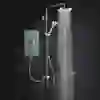Share:
With yet another scorching summer predicted, more of us are looking to reduce our water consumption at home. And, with our bathrooms responsible for much of our water usage, this room is the best place to start.
Combatting water waste in our bathrooms helps play a valuable role in protecting our precious water resources. This not only helps out each summer but, more importantly, long-term. Yet, saving water in this room can also reduce utility bills, especially for those homes with water meters.
An energy-efficient shower that works to lower water consumption can help you save water. Though seemingly a small step, by actively reducing water flow, you can make a big difference. Here, The Bathroom Showroom shows you how easy it is to play a part in creating a more sustainable bathroom.

The Importance of Reducing Water Waste
Water is a precious resource that we often take for granted. With the growing global population and increasing demand for water, it's more important than ever to reduce water waste. By conserving it, we can ensure that future generations have access to clean and safe water.
One of the areas where water waste is most prevalent is in the bathroom, particularly during showers. Showers are responsible for around 25% of water usage in the average British home. But unfortunately, a significant amount of that water goes to waste. So by adopting water-saving practices, we can make a significant impact on water conservation and contribute to a more sustainable future.
Reducing water waste not only benefits the environment but also has a positive impact on our bank accounts! By conserving water, those homes on a water meter can reduce monthly water bills.
Understanding Water Usage in the Shower
Before we can effectively reduce water waste in the shower, it's important to understand how much water we use. The amount of water consumed during a shower depends on various factors such as shower duration and flow rate.
Shower duration is perhaps the most significant factor in water usage. So, the longer we spend in the shower, the more water we consume. Yet if all members of the home can reduce their shower time by just a few minutes each time, substantial amounts of water can be saved.
Another factor to consider is the flow rate of your showerhead. Older shower heads tend to have higher flow rates, which means they use more water per minute. By upgrading to an energy-efficient showerhead with a lower flow rate, you'll significantly reduce water usage without compromising on your shower experience.
The Benefits of an Energy-Efficient Shower Choice
Apart from reducing water waste, there are several other benefits to switching to an energy-efficient shower. Energy-efficient showerheads not only conserve water but also save energy. By using less hot water, you can reduce your energy consumption and lower your utility bills.
And, energy-efficient showerheads are designed to deliver a satisfying shower experience while using less water. Many modern showerheads incorporate advanced technologies such as aerating and laminar flow, which mix air with water to create a luxurious and invigorating shower experience. So, not only will you be saving water and energy, but you'll also be enjoying a more pleasurable shower.

How to Choose an Energy-Efficient Showerhead
When it comes to choosing an energy-efficient showerhead, there are a few key factors to consider:
- Flow Rates: Look for showerheads with a flow rate of 2.0 gallons per minute (GPM) or less. These low-flow showerheads are designed to provide a satisfying shower experience while using significantly less water. A low-flow showerhead is energy-efficient and helps you take big steps towards water conservation as they use less water than traditional showers. The Methven Aurajet Rua shower head is optimised to be water efficient without compromising on performance.

- Spray Patterns: Another important factor to consider is the type of spray pattern. Some energy-efficient showerheads offer adjustable spray patterns, allowing you to customise your shower experience. Look for shower heads that offer a wide range of spray options, including a gentle mist, a concentrated jet, and a pulsating massage. The Grohe Grohtherm 1000 Performance shower ensures an even spray from every nozzle.
- Quality of Shower: It's also worth considering the material and build quality of the showerhead. Opt for shower heads made from sturdy materials such as chrome, like the Mira Activate, or brass and stainless steel. These showerheads are durable and built to last.
- Eco Modes: Showers that have an optional Eco mode can further help save time each time you shower. Located on the Smart valves, Eco modes, like those seen on the Aqualisa Quartz Classic, prompt water saving by as much as up to 33%!
Every Drop Counts - Start Saving Water in Your Bathroom Now
Finally, other smaller but equally feasible measures such as taking cooler showers and using timers can further help with saving water. As hot water requires more energy to heat, opting for cooler showers lets you reduce your energy consumption and save water at the same time.
Likewise, installing a shower timer or making good use of your smart home products is ideal for those that find it challenging to keep track of time. Such devices will alert you when it's time to finish your shower, helping you conserve water.
If you’re considering buying a new energy-efficient shower to help you save water, book an appointment with The Bathroom Showroom. Experts in all things bathrooms, we can help turn your dream bathroom into a reality.
